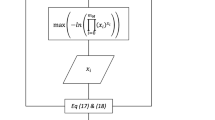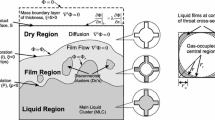Abstract
A pore-network model of evaporation of a binary liquid mixture into a ternary gas phase is developed. The model is applied to study the influence of surface tension gradients induced by composition variations of the liquid on the phase distribution within a capillary porous medium. Numerical simulations based on the proposed model show that the surface tension gradients lead to the accumulation of liquid near the open edge of the network. This surface tension gradient effect is only significant for weakly disordered porous media.
Similar content being viewed by others
References
Schlunder, E. U.: Selective drying of mixture-containing products, Proc. 6th Intern. Drying Symp., Versailles, Sept. 5-8, 1, KL 9-23 (1988).
Ho, C. K. and Udell, K. S.: Mass transfer limited drying of porous media containing an immobile binary liquid mixture, Int. J. Heat and Mass Trans. 38(2) (1995), 339-350.
Morel, D. D., Bourbiaux, B., Latil, M. and Thiebot, B.: 1990, Diffusion effects in gas flooded light oil fractured reservoirs, SPE paper 20516, pp. 433-446.
Le Romancer, J. F., Defives, D. F. and Fernandes, G.: Mechanism of oil recovery by gas diffusion in fractured reservoir in presence of water, SPE/DOE 27746 (1994), pp. 99-111.
Martinez, J. and Setterwall, F.: Gas phase controlled convective drying of solids wetted with multi-component liquid mixtures, Chem. Engng Sci. 46(9) (1991), 2235-2252.
Prat, M.: Discrete models of liquid-vapor phase change phenomena in porous media, Revue générale de Thermique 37 (1998), 954-961.
Tsimpanogiannis, I. N., Yortsos, Y. C., Poulou, S., Kanellopoulos, N. and Stubos, A. K.: Scaling theory of drying in porous media, Phys. Rev. E 59(4) (1999), 4353-4365.
Prat, M.: Isothermal drying of non-hygroscopic capillary-porous materials as an invasion percolation process, Int. J. Multiphase Flow 21(5) (1995), 875-892.
Laurindo, J.B. and Prat M.: Numerical and experimental network study of evaporation in capillary porous media. Phase distributions, Chem. Engng Sci. 51(23) (1996), 5171-5185.
Feder, J.: Fractals, Plenum Press, 1988.
Wilkinson, D. and Willemsen, J. F.: Invasion percolation: a new form of percolation theory, J. Phys. A: Math. Gen. 16 (1983), 3365-3376.
Stephen, K. and Hildwein, H.: Recommended data of selected compounds and binary mixtures, Chemistry Data Series, Vol. IV, Parts 1+2, DECHEMA, 1987.
Gmehling, J. and Onken, U.: Vapor-liquid equilibrium data collections, Chemistry Data Series I/1a,I/2a, DECHEMA, 1982.
Walas, S.: Phase Equilibria in Chemical Engineering, Butterworth-Heinemann, 1985.
Tamura, M., Kurata, M. and Odani, H.: Practical method for estimating surface tensions of solutions, Bull. Chem. Soc. Japan, 28(1) (1955), 83-89.
Cussler, E.L.: Diffusion, Cambridge University Press, 1997.
Whitaker, S.: Role of the species momentum equation in the analysis of the Stefan diffusion tube, Ind. Engng Chem. Fund. 30 (1991), 978-983.
Pratt, K. C. and Wakeham, W. A.: Mutual diffusion coefficients for binary mixtures of water and the isomers of propanol, Proc. Roy. Soc. London, A 342 (1975), 401-409.
Laurindo, J. B. and Prat, M.: Numerical and experimental network study of evaporation in capillary porous media. Drying rates, Chem. Engng Sci. 53(12) (1998), 2257-2269.
Patankar, S. V.: Numerical Heat Transfer and Fluid Flow, Hemisphere Publishing Corporation, Washington DC, 1980.
Sahimi, M.: Flow and Transport in Porous Media and Fractured Rock, VCH, 1995.
Masmoudi, W. and Prat, M.: Heat and mass transfer between a porous medium and a parallel external flow. Application to drying of capillary porous materials, Int. J. Heat Mass Trans. 34(8) (1991), 1975-1989.
Press, W. H., Teukolsky, S. A., Vetterling, W. T. and Flannery, B. P.: Numerical Recipes in Fortran, Cambridge University Press, 1992.
Prat, M.: Percolation model of drying under isothermal conditions in porous media, Int. J. Multiphase Flow 19(4) (1993), 691-704.
Hoshen, J. and Kopelman, R.: Percolation and cluster distribution. I. Cluster multiple labeling technique and critical concentration algorithm, Phys. Rev. B 14 (1976), 3428.
Wilkinson, D.: Percolation model of immiscible displacement in the presence of buoyancy forces, Phys. Rev. A 30(1) (1984), 520-531.
Xu, B., Yortsos, Y. C. and Salin, D.: Invasion percolation with viscous forces, Phys. Rev. E 57(1) (1998), 739-751.
Prat, M. and Bouleux, F.: Drying of capillary porous media with stabilized front in two-dimensions, Phys. Rev. E 60(5) (1999), 5647-5656.
Shaw, T. M.: Drying as an immiscible displacement process with fluid counterflow, Phys. Rev. Lett. 59(15) (1987), 1671-1674.
Le Bray, Y. and Prat, M.: Three-dimensional pore network simulation of drying in capillary porous media, Int. J. Heat Mass Trans. 42 (1999), 4207-4224.
Author information
Authors and Affiliations
Corresponding author
Rights and permissions
About this article
Cite this article
Freitas, D.S., Prat, M. Pore Network Simulation of Evaporation of a Binary Liquid from a Capillary Porous Medium. Transport in Porous Media 40, 1–25 (2000). https://doi.org/10.1023/A:1006651524722
Issue Date:
DOI: https://doi.org/10.1023/A:1006651524722




